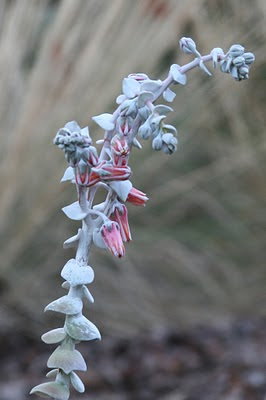Readers of this blog already know that I love color, and people who know me personally know that I very rarely wear neutral colors such as black or gray. But in the garden, it's a different story. First, garden ornaments are often gray, like the solar fountain I got for Christmas from Mr. Mouse.
And the attractive slate plate we received for Christmas from Mr. Mouse's mother.
And I've come to love the California Natives and other native plants that add to the gardener's palette with grayish-green or gray foilage. The first picture in this post shows Eriogonum arborescens (a native buckwheat) together with a mystery succulent that loves my garden, harmonizing nicely with the bleached branches I collected to edge that area.
A mix of native and non-native succulents (the mystery succulent and Dudleya traskiae (Santa Barbara Live Forever) contrast nicely with a small jade plant and the terracotta container.
Dudleya pulverulenta (chalk dudleya) shows off red flowers against gray leaves, a pleasing contrast.
Most native sages shed their green winter/spring foilage as it gets warmer and sprout a new set of smaller, grayish leaves. The gray comes from small hairs that protect the plant from the summer sun. Here a Salvia apiana (white sage) with both green and gray leaves.
And here a Salvia leucophillia (purple sage), already completely gray and contrasting nicely with the dark green manzanita and the bright green coyote brush further back (click to enlarge to see what I mean).
Artemesia delights with fragrance -- it's sometimes called "cowboy's perfume" and feathery gray leaves (here with blossoms of Eriogonum grande rubescens on top).
I'm also very fond of the gray-leaved Zauschneria californica (California fuchsia) I chose as the banner this month. Just as with the chalk dudleya, the contrast of the red and silvery gray is pleasing.
When this plant starts to bloom, I know the rainy season is not too far away. Soon, as the rains come, the salvias change their color and the dominant color in the garden is green again, starting the cycle anew -- only to return to include silvery gray, grayish green, and all the different shades in between the next summer.









Comments